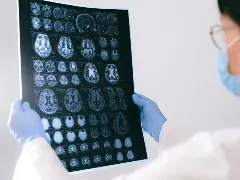

The prostate is an important part of the male reproductive system which is responsible for the production of seminal fluid, a fluid nutrient medium, and the transport in which sperm are suspended. The prostate is located just below the bladder, where it regulates urination.
Prostate cancer, also known as prostate carcinoma or prostate neoplasm, describes a disease in which cells in the prostate gland begin to multiply uncontrollably or without normal cell regulation, causing a tumor. The American Cancer Society speculates 268,490 new cases and approximately 34,500 deaths from prostate cancer in the United States for 2022 and suggests that the risk of prostate cancer is approximately 1 in 8 men over a man's lifetime.
Prostate cancer is a common disease that affects men in middle age or over 50 years. No need to panic because we offer medical tourism which is an effective treatment option for prostate cancer.
What are treatments for Prostate cancer, below is a detailed overview
1. Prostate Cancer: Forms, Symptoms, and Treatment
2. Forms of Prostate Cancer
3. Symptoms of Prostate Cancer
4. How to Treat Prostate Cancer
Forms of Prostate Cancer
A prostatic neoplasm can be classified as:
1. Adenocarcinoma: These originate from the cells of the prostate gland, where prostatic fluid is produced. Adenocarcinoma accounts for the majority of prostate cancer and can be subdivided into
- Acinar adenocarcinoma develops specifically within the glands cell.
- Ductal adenocarcinoma, which emerges from the cells lining the ducts of the prostate gland, is known to be much more aggressive.
2. Urothelial cancer ( often referred to as Transitional cell carcinoma ): As the name suggests, this form of prostate cancer starts in the bladder or urethra and progresses to the prostate.
3. Squamous cell carcinoma of the prostate: This is due to the rapid spread of the squamous (flat) cancerous cells that line the prostate compared to other forms of prostate cancer.
4. Neuroendocrine cancer ( Small cell prostate cancer), which develops from the neuroendocrine system
5. Prostate sarcoma develops from the nerves and muscle (soft tissues)
6. Metastatic prostate cancer: This is the spread of original prostate cancer cells that have migrated to other parts of the body such as the bones, lymph nodes, liver, or brain.
7. Castration-resistant Prostatic carcinoma: When prostate cancer thrives in the presence of low testosterone.
Symptoms of Prostate Cancer
The early stage of prostate cancer is void of symptoms which begins to manifest as the disease progress namely
- Nocturia: frequent and intense urge to urinate at night
- Dysuria: discomfort, while urinating
- Haematuria: blood present in urine
- Hematospermia: blood appears in the semen
- Dysorgasmia: discomfort during ejaculation
- Impotence: Difficulty getting and maintaining an erection
- Numbness of the feet
- Pain spreads through the lower back, hip and chest.
- Fecal incontinence: stool leaks from the anus without warning
How to Treat Prostate Cancer
Many wonders, can Prostate cancer be cured?
The answer is that because prostate cancer is slow growing and localized in some people, treatment for prostate cancer may not be an option for everyone. The key factor to consider before treating prostate cancer is its stage, which is classified as follows
- Early stage, stage I, and stage II: Prostate cancer is in the prostate, with slow growth without symptoms.
- Locally advanced and stage III: Prostate cancer has spread to nearby organs
- Advanced and stage IV: Prostate cancer has spread to distant parts of the body, such as the lungs or bones
This grading system is designed to determine the best prostate cancer treatment option available for each patient.
Treatment for prostate cancer ensures that the cancer is properly treated and cured. Treatment options for prostate cancer are:
- Active surveillance: This is necessary for the early stages, stage I and stage II. Monitoring should be done regularly every 1-3 years
- Watchful Waiting: The focus of prostate cancer treatment here is treating the symptoms, especially in elderly patients
- Radiation therapy: This is the utilization of radiation to kill cancer cells. It can be further classified as
- Brachytherapy: This is an internal radiation therapy done by placing a radioactive seed near cancer for direct destruction
- External radiation therapy: This is the destruction of cancer cells using an external radioactive device
- Systemic therapies: This is the use of androgen deprivation hormone therapy, immunotherapy, or chemotherapy when prostate cancer spreads across other body organs. The medication for prostate cancer management is given due consideration here.
- Focal therapy: this includes the use of laser ablation, photodynamic therapy, high-intensity focused ultrasound, and cryotherapy to target the affected part of the prostate
- Prostatectomy: This is the surgical removal of the prostate gland
Many hospitals specialize in prostate cancer oncology and treatment, and at Airomedical we share that interest with the added benefit of medical tourism services. Our cancer of prostate treatment options are efficient, result-oriented, and affordable.








Comments
Post a Comment